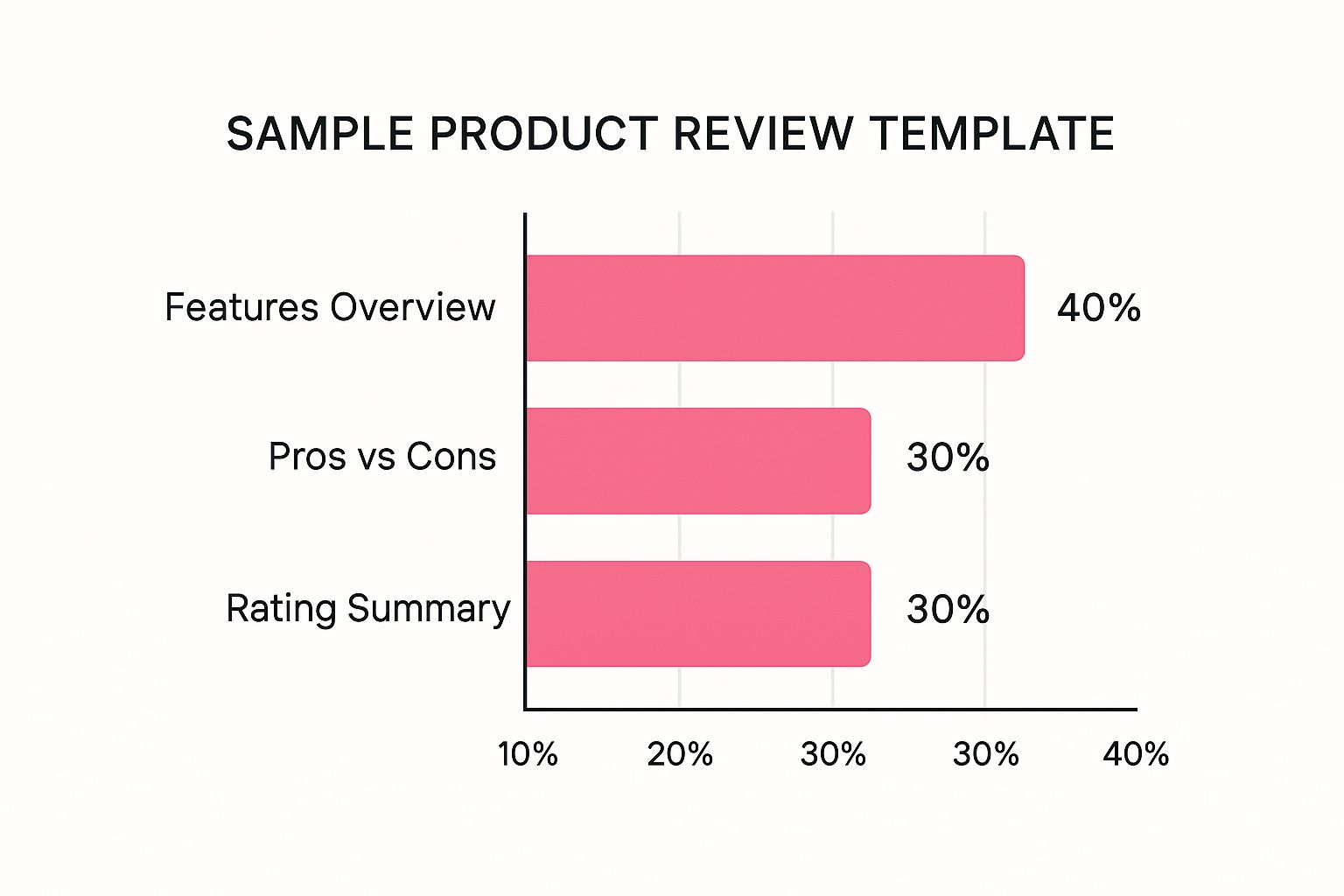Table of contents
Think of a sample product review template not as just some document, but as your secret weapon. When you use a consistent framework for your reviews, you naturally cover all the points your readers are actually looking for. It saves you a tonne of time and, more importantly, builds that all-important trust with your audience.
Why a Solid Product Review Template Matters

Ever read a product review and just… forgotten it moments later? Now, think about one that genuinely helped you make a decision. What was the difference? Nine times out of ten, it's a clear, repeatable structure.
A well-thought-out product review template is your North Star. It guides you through every single evaluation, ensuring you deliver the same high quality, every time.
This isn't just about making your life easier, though. It’s about building credibility. When your readers start to recognise your format, they know exactly where to find the pros and cons, the performance specs, or your final verdict. It’s familiar and reliable.
Building Reader Trust and Confidence
In a world overflowing with opinions, structure is what makes you look like a pro. Having a consistent template shows your readers that you've got a methodical process. It signals that you’re not just winging it, but conducting a proper, thorough assessment. That’s how you earn their trust.
A repeatable framework removes the guesswork. You’re no longer reinventing the wheel with every new product, which frees up mental energy to focus on what truly matters: providing genuine, insightful analysis.
This consistency also helps your audience make smarter choices. Let's say you review three different blenders using the exact same criteria—motor power, ease of cleaning, noise level. Suddenly, your readers can easily compare them side-by-side. This simple act positions you as the go-to expert in your niche.
The Benefits of a Structured Approach
For any content creator, adopting a template is about working smarter, not harder. The advantages are pretty clear once you start.
Here’s what you stand to gain:
- Time Efficiency: A clear outline drastically cuts down on your writing and planning time for every single review.
- Improved Clarity: It helps organise your thoughts into a logical flow that’s a breeze for readers to scan and understand.
- Enhanced Credibility: A professional and consistent format proves you take your reviews seriously, which is key for long-term trust.
- Better Comparisons: You make it incredibly simple for your audience to compare different products you've covered, adding massive value to your content.
What Goes into a High-Impact Product Review?
To write a review that really hits home, you need to know what makes it tick. A great review isn't just a brain dump of your thoughts; it's a carefully crafted piece where every section has a job to do. Think of it less like a rigid checklist and more like a flexible blueprint for building trust and clarity.
When you break down a sample product review template, you'll see the best ones take the reader on a journey. They start with the big picture, zoom in on the nitty-gritty details, and then pull back out to give a clear, confident final say. This structure is key to keeping someone's attention in the noisy online world.
Here’s a quick look at the core components that make up a powerful and comprehensive product review.
Core Components of an Effective Review Template
Each of these parts works together to guide your reader from initial curiosity to a confident purchase decision.
Start With a Compelling Introduction
Your intro is your first handshake with the reader. It has to be personal and get straight to the point. Ditch the generic openings. Instead, kick things off with the problem the product claims to solve or a relatable story about why you were looking for it in the first place.
For instance, if you're reviewing a new scheduling software, you could start with a quick, frustrating anecdote about double-booking clients. That immediately creates a connection and puts the product into a real-world context, making your review feel much more genuine.
The Power of Scannable Summaries
Let's be real: most online readers are skimmers. They want the vital info, and they want it now. This is where a summary box or a ratings breakdown at the top of your review is an absolute game-changer. It gives them an at-a-glance overview of your findings.
This handy infographic shows how the best reviews typically break down their content, putting the focus right where readers need it most.

As you can see, a deep dive into the features and a balanced pros-and-cons discussion make up the real meat of the content, giving readers the substance they're looking for.
Detailing Features with Real-World Context
Just listing a product's features is a rookie mistake. The real magic happens when you translate those features into actual benefits. How does that fancy high-resolution camera really perform in low light? How does that accounting software’s “automated invoicing” feature actually save a small business owner time each month?
This is how you show you’ve properly put the product through its paces. It’s also where balancing the good with the bad becomes so important for your credibility. To really nail this, you can explore our guide on making product testimonials reliable and learn how to build that crucial trust with your audience.
A truly helpful review never just lists specifications. It tells the story of how those specifications perform in the messy, unpredictable real world.
The massive growth of online shopping in Australia really highlights why this detailed, structured approach is so critical. As of 2024, an estimated 17.08 million Australians are shopping online every month—a staggering 45% increase from 2020. With more people than ever relying on digital information to make buying decisions, a well-structured review is the best way to cut through the noise and offer real value.
Adapting Your Review Template for Any Product

A great sample product review template is just a starting point, not a cage. Its real magic comes from how you bend and shape it. Honestly, showing you know your stuff is all about realising which parts of the template to expand on and which to trim down, all depending on the product in front of you.
Your approach to a shiny new laptop, for instance, will be miles away from how you'd tackle a kitchen blender. The basic framework is there, sure, but the focus has to shift. This is what your audience expects, and it's how you deliver genuine value.
Think of it like this: for a laptop, your readers are desperate to know about performance benchmarks, what the keyboard actually feels like to type on, and, of course, real-world battery life. Those are the details that make or break a purchase.
Tailoring for Specific Product Categories
Now, flip that around. A review for a new blender? It needs a completely different lens. You'd want to go deep on things like motor power, blade design, and the absolute pain of cleaning it after blitzing a thick smoothie. These are the practical, everyday things a potential buyer is worrying about.
Let’s break down how you can pivot your template for a few common product types:
- Electronics: This is where you lean into the technical stuff. Prioritise performance specs, the user interface, battery longevity, and overall build quality. Hard data and metrics are your best friends here.
- Home Goods: It's all about real-world use. Focus on durability, how easy it is to use, the aesthetics, and how it fits into a daily routine. Practical scenarios are absolutely key.
- Software/Apps: Here, you'll want to emphasise the user experience (UX), how its key features stack up against competitors, its pricing model, and the quality of customer support.
Your main goal is to get inside your reader's head and answer their most burning questions for that specific item. A generic review just feels lazy. A tailored one? That’s how you build authority and trust.
Real-World Application and Scenarios
Picture yourself reviewing a new smart doorbell. Instead of just listing its camera resolution, you’d actually test its motion detection. Does it get triggered by every passing car, or is it smart enough to tell the difference between a car and a person? You’d also walk the reader through the installation process and how intuitive (or not) the mobile app is.
This kind of specific, customised approach proves you've done the hard yards. It shows you don't just understand the product; you understand the person who wants to buy it. By tweaking and adapting your sample product review template, you turn a simple write-up into a guide that people can't afford to ignore.
Writing Reviews That Build Trust and Authenticity
In a world flooded with sponsored posts and slick marketing, authenticity has become your most valuable asset. The real trick to building genuine trust isn’t about finding a perfect sample product review template; it's about those small, human touches that make a review feel genuinely helpful, not just another sales pitch.
It’s about being real.
The single most important thing you can do? Embrace the flaws. Let’s be honest, no product is perfect, and your readers are smart enough to know that. When you point out the good and the bad, it shows you’ve actually done your homework and aren't just trying to earn a commission. This balanced perspective makes your praise so much more believable.
Be Personal and Relatable
You need to go deeper than a sterile list of features. Weave your own experiences into the review and tell the story of how the product actually fit into your life. For example, instead of just saying a camera has "good battery life," describe taking it on a weekend hiking trip and not even thinking about the charger until you got home on Sunday night.
Your own photos and videos are non-negotiable here. Stock images scream "low effort." But your original content? That's undeniable proof you've actually held and tested the product. It’s a powerful trust signal that immediately sets you apart. How you present these experiences is just as important as the information itself, so if you want to make sure your message hits home, it's worth mastering copywriting for impactful reviews.
Always be transparent about sponsorships or affiliate links. A simple, upfront disclosure doesn’t scare readers away—it builds respect. They get that you need to support your work, and they'll always appreciate the honesty.
Recent studies on Australian consumer behaviour back this up. With economic pressures making every dollar count, shoppers are laser-focused on value. They want reviews that give them honest proof points in straightforward language. This means your personal story, your balanced critique, and your hard-earned recommendation are more critical than ever. In many ways, it's a lot like crafting a powerful testimonial. You can find out more about how to write a testimonial that resonates in our detailed guide.
How to Get Your Reviews Seen and Read

Writing a killer review is really only half the job. If it’s stuck on page ten of Google, it might as well be invisible. Getting eyeballs on your content is all about a smart blend of practical SEO and thinking about the user experience.
First things first, you need to weave keywords into your headings and descriptions, but it has to feel natural. Don't just stuff them in. If you're reviewing a new camera, terms like "low-light performance" or "battery life test" should be part of the conversation, not just a box you’ve ticked.
Of course, your reviews don't exist in a vacuum. To really make them work for you, a wider strategy of ecommerce website optimization is crucial for boosting your entire site's performance and search visibility.
Make Your Content Easy to Scan
Think about how you read online—you probably scan for the good bits, right? Your readers do the same. Use short paragraphs, punchy bullet points, and bold text to make the key takeaways jump off the page. This way, people can grab the most important info fast without being hit by a wall of text.
A huge piece of the visibility puzzle is using structured data, which you might know as schema markup. It’s the behind-the-scenes code that tells search engines what your content is about, and it’s what creates those eye-catching star ratings right there in the search results.
This is becoming even more critical in Australia, where shopping habits are changing. A recent report found that 27% more consumers now kick off their product search on Amazon instead of Google, meaning your reviews need to build trust in a heartbeat. You can dig into this trend and what it means for brand trust in this comprehensive consumer report.
Making your content easy to find and easy to digest is a seriously powerful combination. It doesn't just help with your search ranking; it keeps people hooked once they land on your page. And if you’re looking for more ways to get that feedback loop going, you should learn more about how to get more customer reviews to keep the momentum going.
Got Questions About Writing Product Reviews?
Even with a killer product review template in your back pocket, you're bound to run into a few tricky questions. Let's tackle some of the most common ones I hear, so you can clear those hurdles and get back to writing reviews that connect and convert.
How Long Should a Product Review Be?
Honestly, there's no magic word count. The real goal is always depth, not just length. A great review is one that's comprehensive enough to answer all of your reader's burning questions.
For a pretty straightforward product—say, a new coffee mug or a simple kitchen gadget—you can probably cover everything that matters in 800-1000 words. But when you're diving into something more complex, like the latest smartphone or a dense piece of software, you'll want to aim for 1500 words or more. That extra space gives you room for detailed testing, valuable comparisons, and real-world scenarios that genuinely help people make a decision.
Do I Really Have to Include Negatives in My Review?
Yes. In fact, it's a non-negotiable. No product is perfect, and your audience is smart enough to know that. When you include balanced criticism and are upfront about who a product isn't for, you instantly make your review more believable.
Being honest about a product's flaws shows you’ve put in the work and done a thorough evaluation. This builds an incredible amount of trust with your audience, making your positive points feel far more genuine and powerful.
How Should I Handle Affiliate Links or Sponsorships?
Transparency is everything. You absolutely must disclose any sponsored content or affiliate links, and you should do it clearly right near the top of your review. Most readers get it—creating top-notch content takes time and money—and they actually appreciate the honesty. A simple disclaimer like, "Just so you know, this post may contain affiliate links," is usually all it takes.
Is a Star Rating Better Than a Simple Verdict?
Why not use both? They play different, but equally important, roles.
- Star ratings are fantastic for scannability. They're also what you need to snag those eye-catching rich snippets in Google search results.
- A "recommend/don't recommend" verdict gives a clear, decisive takeaway that leaves no room for confusion.
A really effective approach is to use a star rating in your summary box for a quick snapshot, then follow it up with a detailed final verdict in your conclusion. This lets you explain the why behind your recommendation and—crucially—for whom.
Ready to stop chasing down reviews and start collecting them effortlessly? Testimonial Donut puts your feedback on autopilot, making it simple to request, collect, and showcase amazing reviews from your best customers. Learn more and get started with Testimonial Donut today!



